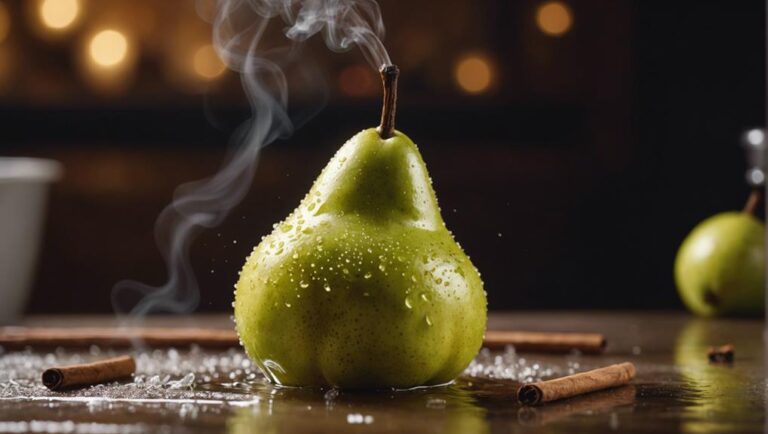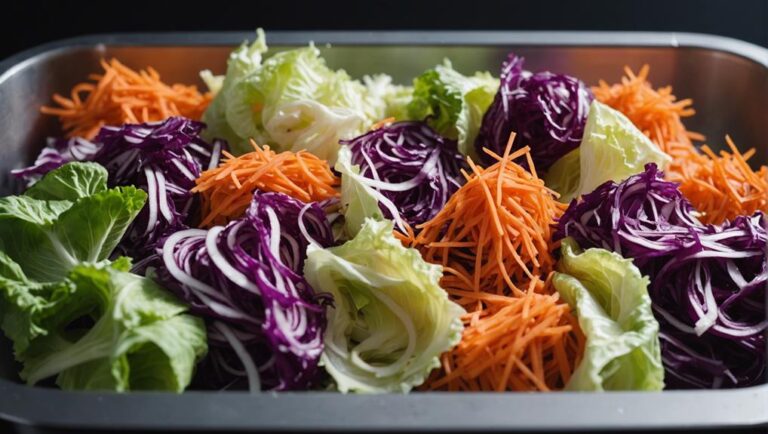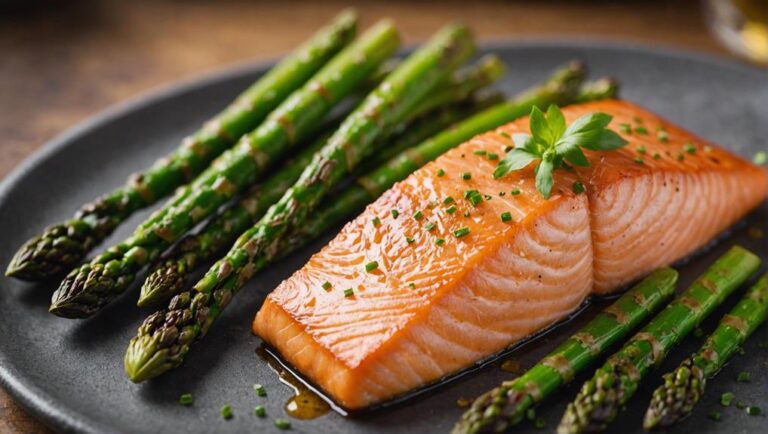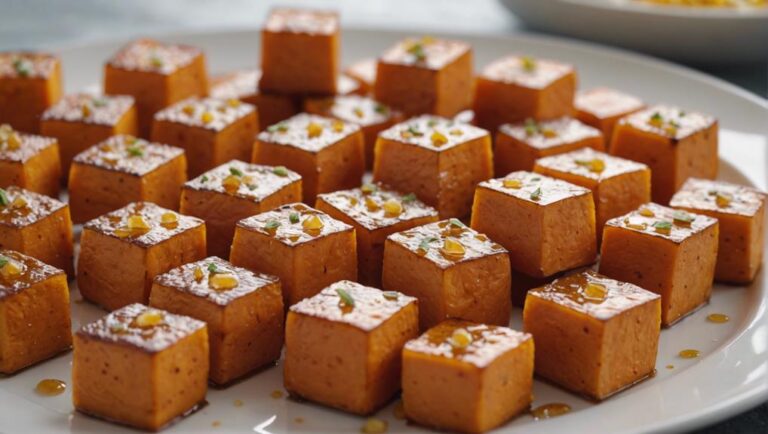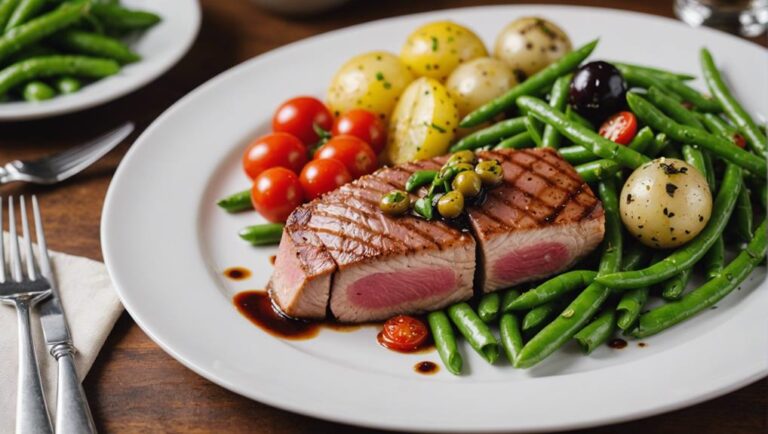Festive Sous Vide Pork Roast With Spiced Apple
Experience a tantalizing blend of flavors and textures in your festive sous vide pork roast paired with the delightful essence of spiced apple. Elevate your taste buds with a perfectly tender and juicy pork roast, meticulously cooked to precision using sous vide technique. Opt for high-quality pork cuts like loin or shoulder to savor maximum flavor. Allow the infusion of spices and herbs to enhance the dish's aroma and taste. The spiced apple touch adds a unique twist to your culinary creation. Uncover the secrets behind achieving this delectable dish by exploring further.
What You Will Learn Here
- Sous vide pork roast ensures juicy, tender meat.
- Spiced apple adds a festive and flavorful twist.
- Precise temperature control for perfect results.
- Searing enhances taste with a caramelized crust.
- Elevate your holiday table with this elegant dish.
Culinary Evolution

As you explore culinary evolution, consider the gradual shift in cooking techniques from traditional to modern methods.
Reflect on how ingredient sourcing changes have influenced the flavors and quality of dishes over time.
Evaluate the impact of modern kitchen innovations on the efficiency and creativity of chefs in today's culinary landscape.
Cooking Techniques Evolution
Through centuries of culinary exploration and innovation, cooking techniques have continuously evolved to meet the demands of changing palates and preferences.
Cooking technology has played a pivotal role in this evolution, with advancements like sous vide cooking offering precise temperature control for perfect results. These innovations not only save time but also enhance flavor profiles by sealing in juices and aromas.
Traditional methods such as roasting or grilling have been revolutionized by new equipment and approaches, providing chefs with more tools to experiment and create unique dishes. The quest for flavor enhancement has led to the development of techniques like smoking, brining, and fermentation, adding depth and complexity to dishes.
As cooking techniques evolve, so do the possibilities for culinary creativity and exploration.
Ingredient Sourcing Changes
In the domain of culinary evolution, the sourcing of ingredients has undergone significant changes, reflecting a shift towards sustainability and quality-driven practices. When it comes to ingredient quality, chefs now prioritize locally sourced, organic produce to enhance flavor profiles and support local communities. This shift has led to a resurgence in heirloom varieties and a focus on seasonal ingredients to elevate the overall dining experience. By sourcing ingredients responsibly, not only are you ensuring the freshness and superior taste of your dishes, but you are also contributing to a more sustainable food system. Below is a table highlighting the key aspects of ingredient sourcing changes in today's culinary landscape:
| Aspect | Description | Impact |
|---|---|---|
| Locally Sourced | Supporting local farmers and producers | Fresher ingredients, reduced carbon footprint |
| Organic Produce | Free from synthetic pesticides and chemicals | Enhanced flavor profiles, healthier option |
| Heirloom Varieties | Rediscovering traditional crop varieties | Unique flavors, preserving biodiversity |
| Seasonal Ingredients | Using produce at its peak freshness | Best taste, better for the environment |
Modern Kitchen Innovations
Experience the cutting-edge advancements shaping modern culinary landscapes with innovative kitchen technologies revolutionizing traditional cooking methods. Smart appliances have taken cooking to a whole new level, offering features like precise temperature control and remote operation through apps.
Digital cooking has made it easier than ever to follow recipes with step-by-step instructions displayed on screens, ensuring perfect results every time. These advancements not only save time but also guarantee consistent outcomes, eliminating the guesswork from the equation.
Whether it's a sous vide machine that maintains water temperature with precision or a smart oven that adjusts settings for best baking, these tools are changing the way we approach cooking, making it more accessible and enjoyable for all.
Key Ingredients
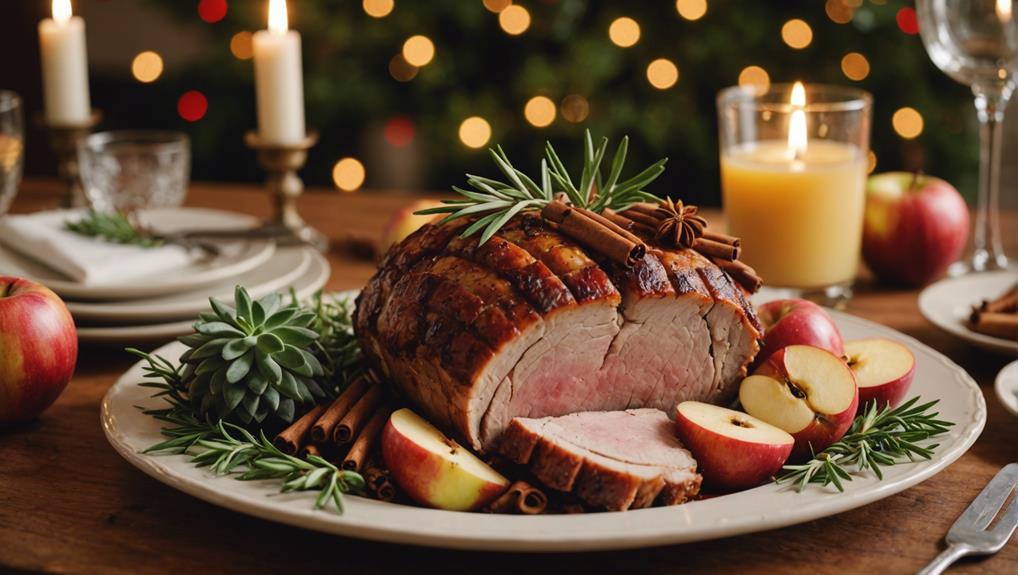
Consider carefully selecting high-quality pork roast, fresh apples, aromatic spices, and fresh herbs to enhance the flavors in this sous vide dish.
- Flavor Pairings: Opt for ingredients that complement each other well. Pork pairs beautifully with apples, creating a sweet and savory balance. The addition of warm spices like cinnamon, nutmeg, and cloves enhances the overall taste profile.
- Cooking Techniques: Sous vide cooking guarantees that the pork roast is perfectly tender and juicy. By vacuum-sealing the ingredients and cooking them in a water bath at a precise temperature, you lock in the flavors and achieve consistent results. This method allows for ideal infusion of the spices and herbs into the meat for a flavorful outcome.
- High-Quality Pork Roast: Choose a well-marbled pork roast cut for maximum flavor and tenderness. Look for cuts like pork loin or pork shoulder for the best results.
- Fresh Ingredients: Always use fresh apples, herbs, and spices to elevate the dish's taste. Freshness enhances the overall aroma and flavor of the sous vide pork roast, making it a delightful centerpiece for your festive occasion.
Trending Pork Roast Variations
Trending Pork Roast Variations include the succulent Sous Vide Pork Loin, a flavorful Savory Pork Rub Recipe, and a delightful Spiced Apple Glaze Recipe.
Each variation brings a unique twist to the classic pork roast, offering a range of flavors and textures to explore.
Experimenting with these trending variations can elevate your pork roast game and impress your guests with a delicious meal.
Sous Vide Pork Loin
When preparing a sous vide pork loin, ensuring precise temperature control throughout the cooking process is essential for achieving a perfectly tender and juicy roast.
- Sous Vide Benefits
- Sous vide cooking allows for precise temperature control, ensuring the pork loin is cooked evenly.
- Pork Loin Tenderness
- The gentle cooking process of sous vide helps retain the natural juices of the pork loin, resulting in a tender texture.
- Flavor Infusion
- Sous vide cooking allows you to infuse the pork loin with herbs, spices, and aromatics, enhancing its flavor profile.
- Consistent Results
- With sous vide, you can consistently achieve the desired level of doneness in your pork loin, eliminating the risk of overcooking.
Savory Pork Rub Recipe
To elevate the flavor profile of your pork roast, consider incorporating a savory pork rub recipe that's currently gaining popularity among home chefs and food enthusiasts alike. When preparing your pork roast, a well-crafted pork rub can make all the difference. Here are some key elements to keep in mind:
- Flavorful Marinades: Experiment with different marinades to infuse your pork with rich and complex flavors.
- Slow Cooking: Opt for slow cooking methods to allow the flavors from the pork rub to penetrate the meat thoroughly.
- Meat Seasoning: Make sure your pork rub has a balanced mix of herbs, spices, and seasonings to enhance the taste of the meat.
- Temperature Control: Monitor the cooking temperature carefully to achieve a juicy and tender pork roast.
Spiced Apple Glaze Recipe
Consider enhancing your sous vide pork roast with a delectable Spiced Apple Glaze to add a burst of flavor and complexity to your dish. Here are some tips to make the most out of your Spiced Apple Glaze:
- Apple Glaze Alternatives: Experiment with using pear or quince instead of apples for a unique twist on your glaze.
- Flavor Pairings: Pair your Spiced Apple Glaze with a hint of cinnamon and a touch of maple syrup for a warm and comforting flavor profile.
- Glazing Techniques: Brush your glaze on the pork roast during the last few minutes of cooking for a glossy finish.
- Presentation Ideas: Drizzle any extra glaze over your sliced pork roast before serving for an extra pop of flavor and visual appeal.
Searing for Added Flavor
When it comes to enhancing the flavor of your sous vide pork roast, you're about to discover a whole new world of taste.
The perfect sear can elevate your dish from good to exceptional, creating a beautiful crust and sealing in those succulent juices.
Paying attention to the searing process is key to achieving that mouthwatering taste you crave.
Enhancing Flavor With Searing
For a bolder, more complex flavor profile in your sous vide pork roast, searing the meat before or after cooking can elevate the taste experience to new heights. Searing techniques play an essential role in flavor enhancement by creating a delicious crust on the pork roast.
Whether you prefer a quick sear before the sous vide bath to lock in juices or a post-sous vide sear for a crispy exterior, both methods contribute to enhancing the overall flavor of the dish. The Maillard reaction that occurs during searing adds depth and richness to the meat, providing a contrast to the tender interior achieved through sous vide cooking.
Experimenting with different searing techniques allows you to customize the flavor profile to suit your preferences, making each bite a delightful culinary adventure.
Importance of Proper Sear
To truly enhance the depth of flavors in your sous vide pork roast, achieving a proper sear is essential for revealing a symphony of taste sensations.
The essential sear plays a vital role in flavor enhancement by creating a caramelized crust on the exterior of the pork roast, locking in juices and intensifying the savory notes.
When the pork is seared correctly, you'll experience a delightful contrast between the crispy outer layer and the tender, juicy interior, elevating the overall dining experience.
The Maillard reaction, triggered during searing, adds complexity and depth to the flavor profile, resulting in a more robust and satisfying taste.
Tips for Successful Searing
For maximum flavor enhancement, guarantee your pork roast achieves a perfect sear by following these essential tips. Searing techniques play a vital role in creating a delicious crust on your pork roast.
To achieve the desired Maillard reaction, make sure your pan is preheated adequately. Temperature control is key; a hot pan is necessary to promote browning without overcooking the meat. Before searing, pat your pork roast dry to remove excess moisture, allowing for a better sear.
When placing the roast in the pan, avoid overcrowding to prevent steaming instead of searing. Remember, don't move the meat too soon – let it develop a crust before flipping. By mastering these searing techniques, you'll elevate the overall flavor profile of your festive pork roast.
Final Thoughts
In reflecting on this Sous Vide Pork Roast with Spiced Apple recipe, consider the harmonious blend of flavors and the tender juiciness that results from the precise cooking method. The festive presentation and flavor balance make it an ideal choice for your holiday gatherings. The sous vide perfection achieved with this dish ensures that every bite is a succulent delight.
—
| Final Thoughts | Pros | Cons |
|---|---|---|
| Flavor Balance | Perfectly seasoned pork with a hint of spiced apple brings a delightful taste sensation. | Some may find the apple flavor too subtle; adjust spices to personal preference. |
| Juiciness | The sous vide method locks in moisture, resulting in a juicy and tender pork roast. | Searing at the end might require careful attention to avoid overcooking the outer layer. |
| Festive Presentation | A visually appealing dish that adds elegance to your table setting. | Requires some planning ahead due to the sous vide cooking process. |
| Ease of Cooking | Simple steps and precise temperature control make this recipe beginner-friendly. | Sous vide equipment may not be readily available to all home cooks. |
| Versatility | The spiced apple can be customized with different seasonings to suit various palates. | Leftovers might not be as juicy when reheated; consider repurposing in salads or sandwiches. |
—
Frequently Asked Questions
Can I Use a Different Type of Meat for This Recipe?
If you want to switch up the meat in this dish, feel free to explore different options like chicken, beef, or lamb. Adjust cooking times and temperatures accordingly, and experiment with flavor substitutions for a personalized touch.
How Long Should I Let the Pork Rest Before Slicing?
Before slicing the pork, let it rest for at least 10-15 minutes. This resting time allows the juices to redistribute, enhancing flavor absorption and ensuring a juicy cut. Use a sharp knife for clean slices and beautiful presentation aesthetics.
Can I Skip the Searing Step for a Quicker Meal?
If you're short on time, you can skip the searing step for a quicker meal. While searing enhances flavors, sous vide efficiency still delivers a tasty dish. Consider searing alternatives like broiling or using a blow torch for flavor impact.
What Other Fruits Can Be Used Instead of Apples?
For a different flavor profile, consider using pears as a substitute for apples in your dish. Alternatively, a mango could add a tropical twist. If you're feeling adventurous, a citrus or berry variation could also complement your pork roast.
Is It Necessary to Tie the Pork Roast With Butcher's Twine?
You can skip tying the pork roast with butcher's twine if using a sous vide cooking technique. The twine helps the roast maintain shape during traditional cooking. Presentation-wise, using twine can enhance the visual appeal of the dish.
Conclusion
Indulge in the succulent flavors of sous vide pork roast with spiced apple, a festive dish that will elevate any gathering.
The tender meat, infused with aromatic spices, is sure to impress even the most discerning palates.
Searing the roast adds a delicious caramelized crust, enhancing the overall experience.
This trendy twist on a classic dish is a must-try for anyone looking to elevate their culinary skills and delight their guests.
Cheers to a delicious and memorable meal!






